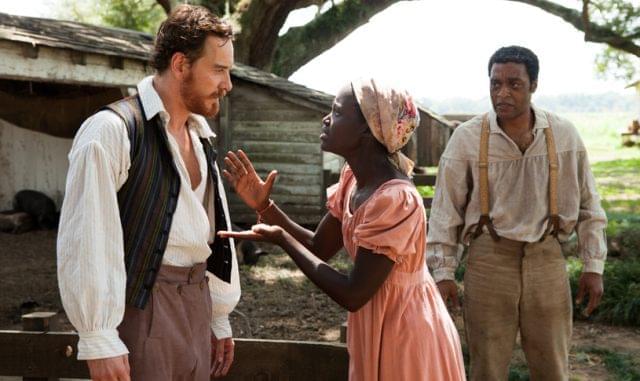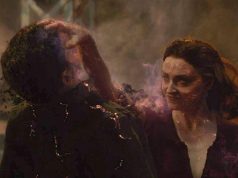
There are three devastating, longer-than-average shots in “12 Years a Slave” that encapsulate the film’s greatness, both as a movie and as cultural commentary. Two of them, though they depict abject cruelty, may seem otherwise unremarkable at first glance, but they actually speak volumes about the movie’s approach to the ghastly subject of American slavery. The third shot’s notability is unmistakable, and it showcases director Steve McQueen’s brilliance while underscoring his thematic intent.
We will discuss these three shots not in chronological order but in the order that suits us best, because it’s our review and we can do what we want.
Shot #1 is in a scene 15 minutes into the film, when Solomon Northup (Chiwetel Ejiofor), a prosperous black man living in New York in 1841, has just been kidnapped by slavers in Washington, D.C. Solomon has been free his entire life, aware of the horrors of slavery but spared from experiencing them firsthand. His initial reaction to being abducted and chained in a shack is righteous indignation: I’m not a runaway slave, I’m a freeman, you have no right to do this, etc. The law is on his side, of course, but we note the awful absurdity of the situation: if he were a slave, caging and beating him would be perfectly legal. As a black man, the only thing that makes him a human being instead of property is a piece of paper.
His captors seek to make it clear to Solomon that he is no longer a freeman from Saratoga, N.Y. As of this moment, he’s a runaway n***** from Georgia. But for their plan to work, Solomon’s will has to be broken. A slave who’s constantly whining about how he’s not supposed to be a slave, and how he has a wife and children back in Saratoga, and how he could clear all this up if you’d just give him the chance, would be a liability.
Which brings us to the shot: an unbroken 85-second take in which Solomon is forced to his hands and knees and savagely beaten across the back until he submits to his new status as a slave. The ugly man doing the dirty work uses a plank of wood until it splinters, then asks Solomon if he’s a slave. Solomon whimpers something that sounds like “no,” so now it’s on to the whip to finish the job of breaking his spirit. Finally Solomon accepts that if he doesn’t stop objecting, he’ll be killed.
And that’s how you make a human being relinquish his humanity: through brute force. There’s no other way. Rhetoric, propaganda, and constant negative reinforcement can help make one group of people subservient to another, but it can’t do the whole job. The only way slavery was able to continue was through physical violence.
By depicting it so matter-of-factly, in a single shot, without flinching, McQueen drives the bleak reality of Solomon’s situation home to viewers who’ve never experienced anything remotely like it — viewers who perhaps imagine that if they were in Solomon’s shoes, they would assert their freedom even to the death. This is critical to the film, not just thematically but in terms of storytelling: since Solomon is going to be a slave for the next 12 years, we need to believe that he could be forced into it. McQueen makes sure we believe.
Shot #2 is at the opposite end of the movie, in the final half-hour. Solomon is working under a particularly loathsome plantation owner named Edwin Epps (Michael Fassbender), a Bible-quoting drunkard and rapist whom Solomon tactfully describes as “a man of hard countenance.” (One of the things I like about John Ridley’s screenplay, based on the real Solomon Northup’s memoir, is how even casual conversation sounds elegantly formal by modern standards.) Epps’ own wife (Sarah Paulson) is more direct, calling her husband “a no-account bastard,” though she’s mostly just jealous because Epps favors a slave girl, Patsey (Lupita Nyong’o), over her.
The multi-layered conflict between Epps, his wife, Solomon, and Patsey comes to a head in an astonishing scene consisting of a single take that lasts 4 minutes and 45 seconds, in which Patsey is stripped naked, tied to a post, and mercilessly whipped. To make it crueler, Epps forces Solomon to do some of the whipping.
The scene is almost unbearable to watch (I know I am not making this movie sound very appealing), but it’s a masterwork of filmmaking. Ejiofor, Fassbender, and Nyong’o give impeccable, heartbreaking performances that cover a range of intense emotions even as they also handle the complicated logistics involved in choreographing the shot.
Because the scene is so horrifically compelling, and because the camera moves around a lot, I didn’t realize on first viewing that it was shot in a single take. It’s difficult to stage any shot of that length, let alone one involving background extras, simulated violence, and extreme emotional duress. Why did McQueen do it this way, rather than with ordinary cutting and editing?
As with the previous example, I think it’s to give the scene a sense of immediacy. Not cutting away (not even to another angle of the same action) is the filmmaking equivalent of staring at something without blinking. Whether we consciously realize it or not, we as viewers are drawn into it, unable to relax until finally we cut to something else.
Shot #3 is in the middle of the film, and it’s the one that even a casual viewer will recognize as a singular piece of work. At this point, Solomon is owned by a master named Ford (Benedict Cumberbatch) who treats him with relative kindness. But while Ford is away, Solomon runs afoul of one of his overseers, a petulant brat named Tibeats (Paul Dano) who genuinely, truly hates n*****s. Tibeats and his lackeys string Solomon up in a noose, intending to hang him, but are prevented from finishing the job by a higher-up who points out that since Solomon is Ford’s property, nobody but Ford has the right to kill him. Tibeats and company retreat, leaving Solomon in the noose, his hands tied behind his back, his toes touching the ground just enough to keep him alive in what looks like an obscene parody of a dance.
And there he stays. For hours. Shot #3 is 85 seconds long. The camera remains still, Solomon gasping and struggling in the foreground while in the background life on the plantation continues. No one, slave or white person, dares rescue him, though a slave does eventually come and give him a sip of water. Slaves go about their work; children play; life proceeds normally even though there is a man hanging from a tree right in front of them.
This is McQueen’s metaphor for the institution of slavery. For decades, while unthinkable cruelty was being inflicted daily on millions of human beings, society went about its business, unable or unwilling to change it. I don’t mean that as a condemnation of average Americans in the 1800s, any more than we judge the slaves in the film for not coming to Solomon’s aid. Part of what made slavery so insidious was the fact that it was a massive, well-established institution that the average person couldn’t fight even if he wanted to. This was normal.
I don’t think we’ve ever fully reckoned with that, with the reality that for many decades, this thing that is very obviously wrong was not considered wrong. What were we — and I mean all the societies that condoned slavery, though the film is about America specifically — thinking? “12 Years a Slave” forces us to consider the actual, literal, day-to-day monstrousness of slavery in a way that few works of art ever have.
But it’s also a stellar piece of cinema, artfully directed and performed, full of haunting beauty. McQueen doesn’t sensationalize or wallow in the depravity: apart from the three scenes discussed, there isn’t a great deal of graphic violence. And there runs through it an undercurrent of hope. We know Solomon will eventually be free, and his refusal to give up entirely — even as he has to make certain concessions to stay alive — is inspiring. The film is exactly the sort of thing we mean when we talk about the arts reflecting, ennobling, and strengthening a culture.
[ On the complete opposite end of the seriousness spectrum, I also recorded “Randy Newman’s Title Song from ’12 Years a Slave'” ]
A (2 hrs., 14 min.; )





